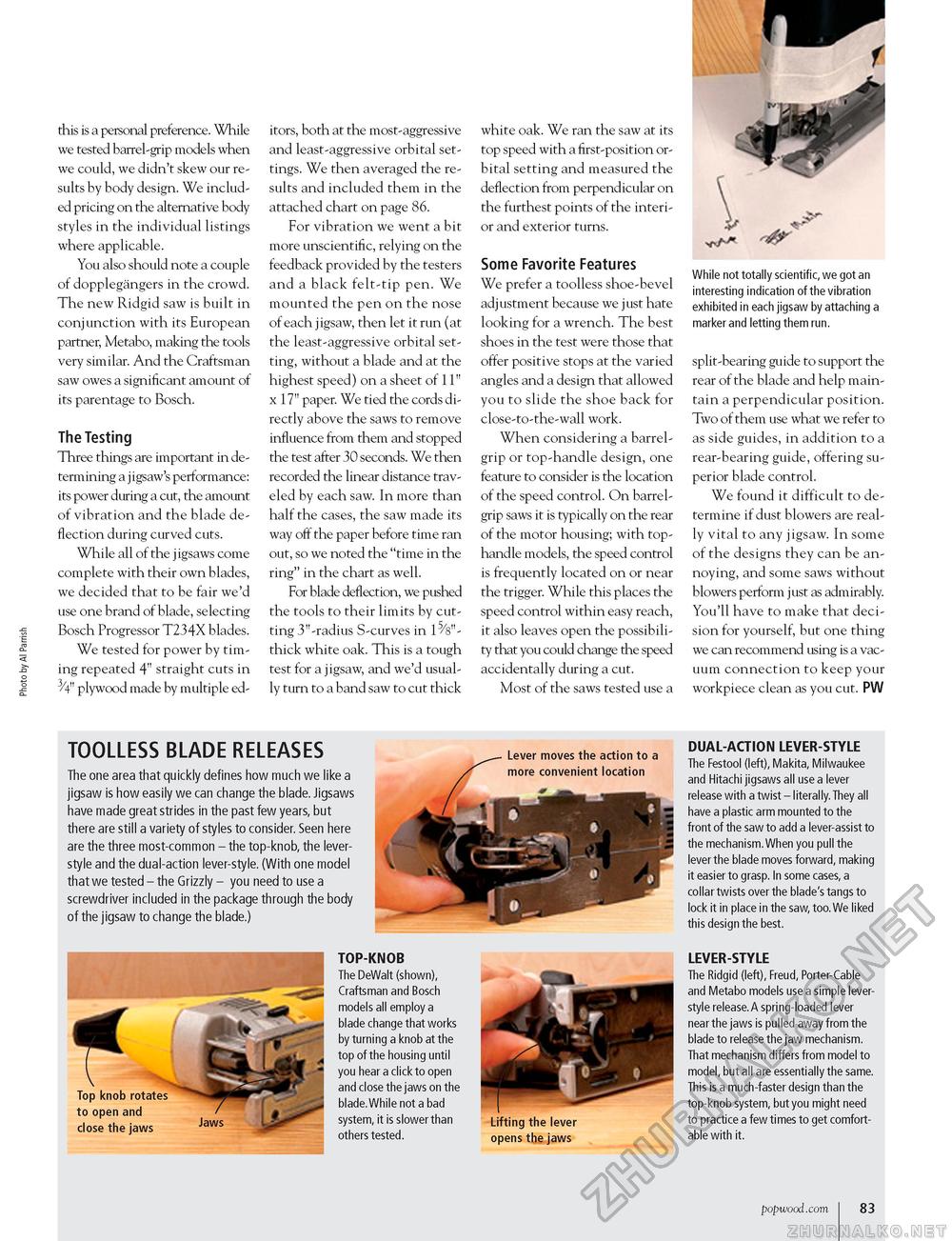Popular Woodworking 2003-11 № 137, страница 84
this is a personal preference. While we tested barrel-grip models when we could, we didn't skew our results by body design. We included pricing on the alternative body styles in the individual listings where applicable. You also should note a couple of dopplegangers in the crowd. The new Ridgid saw is built in conjunction with its European partner, Metabo, making the tools very similar. And the Craftsman saw owes a significant amount of its parentage to Bosch. The Testing Three things are important in determining a jigsaw's performance: its power during a cut, the amount of vibration and the blade deflection during curved cuts. While all of the jigsaws come complete with their own blades, we decided that to be fair we'd use one brand of blade, selecting Bosch Progressor T234X blades. We tested for power by timing repeated 4" straight cuts in 3/4n plywood made by multiple ed itors, both at the most-aggressive and least-aggressive orbital settings. We then averaged the results and included them in the attached chart on page 86. For vibration we went a bit more unscientific, relying on the feedback provided by the testers and a black felt-tip pen. We mounted the pen on the nose of each jigsaw, then let it run (at the least-aggressive orbital setting, without a blade and at the highest speed) on a sheet of 11" x 17" paper. We tied the cords directly above the saws to remove influence from them and stopped the test after 30 seconds. We then recorded the linear distance traveled by each saw. In more than half the cases, the saw made its way off the paper before time ran out, so we noted the "time in the ring" in the chart as well. For blade deflection, we pushed the tools to their limits by cutting 3"-radius S-curves in 15/8"-thick white oak. This is a tough test for a jigsaw, and we'd usually turn to a band saw to cut thick white oak. We ran the saw at its top speed with a first-position orbital setting and measured the deflection from perpendicular on the furthest points of the interior and exterior turns. Some Favorite Features We prefer a toolless shoe-bevel adjustment because we just hate looking for a wrench. The best shoes in the test were those that offer positive stops at the varied angles and a design that allowed you to slide the shoe back for close-to-the-wall work. When considering a barrel-grip or top-handle design, one feature to consider is the location of the speed control. On barrel-grip saws it is typically on the rear of the motor housing; with top-handle models, the speed control is frequently located on or near the trigger. While this places the speed control within easy reach, it also leaves open the possibility that you could change the speed accidentally during a cut. Most of the saws tested use a While not totally scientific, we got an interesting indication of the vibration exhibited in each jigsaw by attaching a marker and letting them run. split-bearing guide to support the rear of the blade and help maintain a perpendicular position. Two of them use what we refer to as side guides, in addition to a rear-bearing guide, offering superior blade control. We found it difficult to determine if dust blowers are really vital to any jigsaw. In some of the designs they can be annoying, and some saws without blowers perform just as admirably. You'll have to make that decision for yourself, but one thing we can recommend using is a vacuum connection to keep your workpiece clean as you cut. PW TOOLLESS BLADE RELEASES The one area that quickly defines how much we like a jigsaw is how easily we can change the blade. Jigsaws have made great strides in the past few years, but there are still a variety of styles to consider. Seen here are the three most-common - the top-knob, the lever-style and the dual-action lever-style. (With one model that we tested - the Grizzly - you need to use a screwdriver included in the package through the body of the jigsaw to change the blade.) DUAL-ACTION LEVER-STYLE The Festool (left), Makita, Milwaukee and Hitachi jigsaws all use a lever release with a twist - literally. They all have a plastic arm mounted to the front of the saw to add a lever-assist to the mechanism.When you pull the lever the blade moves forward, making it easier to grasp. In some cases, a collar twists over the blade's tangs to lock it in place in the saw, too.We liked this design the best. TOP-KNOB The DeWalt (shown), Craftsman and Bosch models all employ a blade change that works by turning a knob at the top of the housing until you hear a click to open and close the jaws on the blade.While not a bad system, it is slower than others tested. LEVER-STYLE The Ridgid (left), Freud, Porter-Cable and Metabo models use a simple lever-style release.A spring-loaded lever near the jaws is pulled away from the blade to release the jaw mechanism. That mechanism differs from model to model, but all are essentially the same. This is a much-faster design than the top-knob system, but you might need to practice a few times to get comfortable with it. popwood.com 83 |








